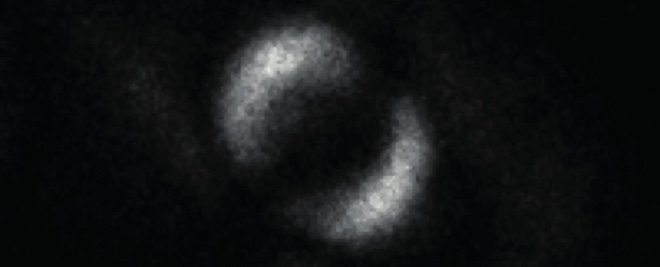For the first time scientists photographed the phenomenon of quantum entanglement, which Einstein once called 'spooky impact'.
Quantum entanglement is one of the most famous and interesting phenomena occurring in the microscopic world, allowing two objects at any distance (several meters or several light years) to interact and influence up news to each other. This phenomenon has been called by Albert Einstein as "Spooky action at a distance" temporarily translated as "ghostly effect from afar".
This is the first time in history that physicists from Glasgow University, Scotland have taken a picture that demonstrates the existence of quantum entanglement and ghost effects. These phenomena can become the basis for scientists to develop new technologies such as quantum computers, telecommunications and quantum Internet .
 For the first time scientists photographed the phenomenon of quantum entanglement, which Einstein once called 'spooky impact'. Picture 1
For the first time scientists photographed the phenomenon of quantum entanglement, which Einstein once called 'spooky impact'. Picture 1 When two particles at any distance still have close ties, quantum entanglement will occur. What happens to a particle is that the particle is affected even though its distance can be up to light years, even on the other side of the black hole.
Eisntein called this influence "spooky impact" and did not believe in its existence. He said a sentence that made quantum entanglement famous, "God does not play dice" and challenges other scientists to find evidence for its existence and "spooky impact".
Numerous scientists have accepted Eisntein's challenge. In 1964, John Stewart Bell - Northern Irish physicist stated Bell's theorem named after him, indicating that quantum entanglement is the difference between the quantum world and classical mechanics.
 For the first time scientists photographed the phenomenon of quantum entanglement, which Einstein once called 'spooky impact'. Picture 2
For the first time scientists photographed the phenomenon of quantum entanglement, which Einstein once called 'spooky impact'. Picture 2 By 1982, a group of physicists was able to prove the existence of "spooky effects" in mathematics. By 2015, scientists conducted a first test that confirmed the existence of quantum entanglement.
And this year, with a photograph of what happens between two quantum-entangled photons, scientists find more evidence that they can interact and share physical states with each other in moments .
To capture this incredible image, Paul-Antoine Moreau, the lead author of the study and a group of physicists, created a system that blew out the entangled photons into what they described as' objects are not normal '. And they have taken 4 images of photons under 4 different phase transitions.
 For the first time scientists photographed the phenomenon of quantum entanglement, which Einstein once called 'spooky impact'. Picture 3
For the first time scientists photographed the phenomenon of quantum entanglement, which Einstein once called 'spooky impact'. Picture 3 The final image is a stack of multiple 4-photon shots that scientists take when they undergo a series of phase transitions. They separated quantum entangled photons from each other and activated four transition phases by launching one of the two beams through the liquid crystal β-barium borate.
 For the first time scientists photographed the phenomenon of quantum entanglement, which Einstein once called 'spooky impact'. Picture 4
For the first time scientists photographed the phenomenon of quantum entanglement, which Einstein once called 'spooky impact'. Picture 4 In the process, they took photographs that showed that the photon did not pass through the crystal material and also underwent phase transitions when entangled with the remaining photons. This means they have been entangled with quantum.
- Successful fabrication of quantum compass to atomic level, replacing GPS in the future
You should read it
- For the first time successfully implementing underwater quantum teleportation, China took the lead in the quantum communication race
- For the first time, scientists have successfully implemented quantum shifts between two chips
- Insert the photon into the empty space inside the diamond
- Intel challenged IBM and Google with supercomputers with 250 times cooler temperatures than the universe
- Quantum computing - a marathon, not a sprint contest!
- What is quantum computing and how did people develop this technology?
- New chip technology can enhance quantum computing
- China successfully developed 'handheld' quantum satellite communications equipment
- Join Microsoft's free Quantum computing course today
- Quantum computing - the future of humanity
- Tips for using Firefox Quantum
- Successful fabrication of quantum compass to atomic level, replacing GPS in the future
May be interested

What is cholesterol? Distinguish good cholesterol and bad cholesterol in the body

List of good fruits and vegetables for gout patients

15 most giant animals in the natural world

Bad news: German cockroaches have evolved to become 'immortal', the chemical technology in hand

Falling money from the sky is real: A $ 700 billion gold meteorite is flying 750 million kilometers from Earth.

The most expensive fish in the world, the highest record is over 71 billion a tuna






 What do you know about the great genius Albert Einstein
What do you know about the great genius Albert Einstein For the first time, scientists have successfully implemented quantum shifts between two chips
For the first time, scientists have successfully implemented quantum shifts between two chips The mystery behind the stolen brain of Albert Einstein genius
The mystery behind the stolen brain of Albert Einstein genius Scientific perspective: Can people travel time?
Scientific perspective: Can people travel time? Insert the photon into the empty space inside the diamond
Insert the photon into the empty space inside the diamond Scientists have found a way to create 'liquid light' easily
Scientists have found a way to create 'liquid light' easily